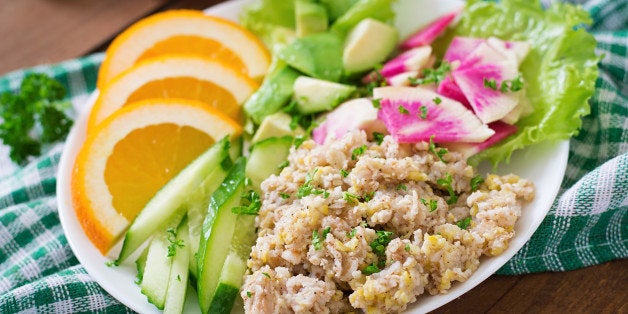
As a registered dietician, it is often my job to translate research and guidelines into step-by-step recommendations that are easy for anyone to follow, so I was delighted to find that the newly released 2015-2020 Dietary Guidelines for Americans are simple and easy to manage and aim to help Americans make healthier eating decisions.
In order to reduce the risk of chronic disease for everyone from toddlers to seniors, the updated Dietary Guidelines help us include foods we love by recommending healthy eating patterns. Working to create a healthful pattern of eating, instead of focusing on individual foods or nutrients, allows for a tailored approach based on an individual's daily activity, culture, gender, and other influential elements. I'd like to share a few helpful tips selected from the Dietary Guidelines that you can practice to inch you closer to your goals today.
Small change is key -- Start with one change at a time until it comes naturally. It's like organizing your cabinets; you can attempt to organize all of them at once and end up with a mess on your floor and nothing accomplished (personal experience!) or you can select one cabinet at a time and arrange its contents in a timely and efficient manner.
These changes can be simple goals such as drinking water every hour, switching your afternoon snack to a piece of fresh fruit instead of a packaged treat or replacing two meals a week with a variety of seafood such as a tuna sandwich for lunch or shrimp for dinner. No matter which goal you choose, always start with the easiest change and build incrementally, working up to the most difficult ones.
A variety of foods is key -- An easy way to meet your individual nutrient needs is by eating a variety of foods (from different food groups) each day. This means eating a range of produce, to remain within your calorie needs and make your plate creative and colorful. Try to include vegetables from the following groups: dark green, red and orange, legumes (beans and peas), starchy, and other.
It's not just fruits and vegetables we need to vary, it's important to have a variety of lean protein sources, including seafood, lean meats and poultry, eggs, legumes (beans and peas), and nuts, seeds, and soy products. Seafood is among the few power foods Americans are encouraged to consume more often for their health. Since the average American eats about half of the recommended amount of seafood, working to get your two to three meals of a variety of seafood per week is an important goal. Additionally, the omega-3 fatty acids found in fish, called EPA and DHA, help improve the brain development of babies during pregnancy and breastfeeding.
Simple and subtle substitutions can make a big difference -- Every little change makes a difference and can help you achieve your health goals. Here are a few simple changes:
1.Swap whole milk for low-fat or skim milk in your coffee or morning cereal
2.Try adding low-fat yogurt in the place of sour cream and heavy cream in savory dishes to keep the creamy taste and ditch the saturated fat
3.Swap whole grains in for enriched white flour products. Play around and try out new grains like quinoa or bulgur wheat for variety!
4.Shift to eating two three servings of seafood each week by choosing a fish fillet instead of chicken or turn to the tuna in your pantry for an easy and accessible no-cook protein
5.Instead of using just salt, get creative by adding fresh herbs or even garlic and onions to boost flavor and save on sodium
6.Try out some smaller plates and cups to help you create smaller portions. You can use salad plates for your meal and serving creamy soups in a mug.
There are many simple ways you can make a big difference, these are just a few!
Partner with your community - The United States is a cultural melting pot, providing plenty of food options for every culinary preference. When working with people from different geographic locations, we must consider their food preferences and cultural distinctness. Plus, there are so many traditions to explore and a variety of ingredients to try! For example, Hispanics have a genuine appreciation for strong, bold flavors and more often than not, food is the center of their frequent and charismatic celebrations. Communities can come together to adjust portion size or find healthier cooking methods rather than trying to eliminate their go-to foods, helping everyone celebrate and make healthful choices.
Daily activities -- From daily work demands and balancing the kids' extracurricular schedules, it seems that no one feels like they have time to exercise anymore!
However, a healthy eating pattern must be paired with daily activity to optimize health outcomes.
Every step counts so consider walking or riding your bike to do your errands, or get off a stop earlier on public transit and walk an extra block or two (take advantage of those beautiful days). Try standing during phone conversations, get up and move during commercials, etc. The trick is to keep moving throughout the day, try a goal to get on your feet every hour.
Remember, every little change inches you closer to improving your health, just take a deep breath and go one-step at a time.